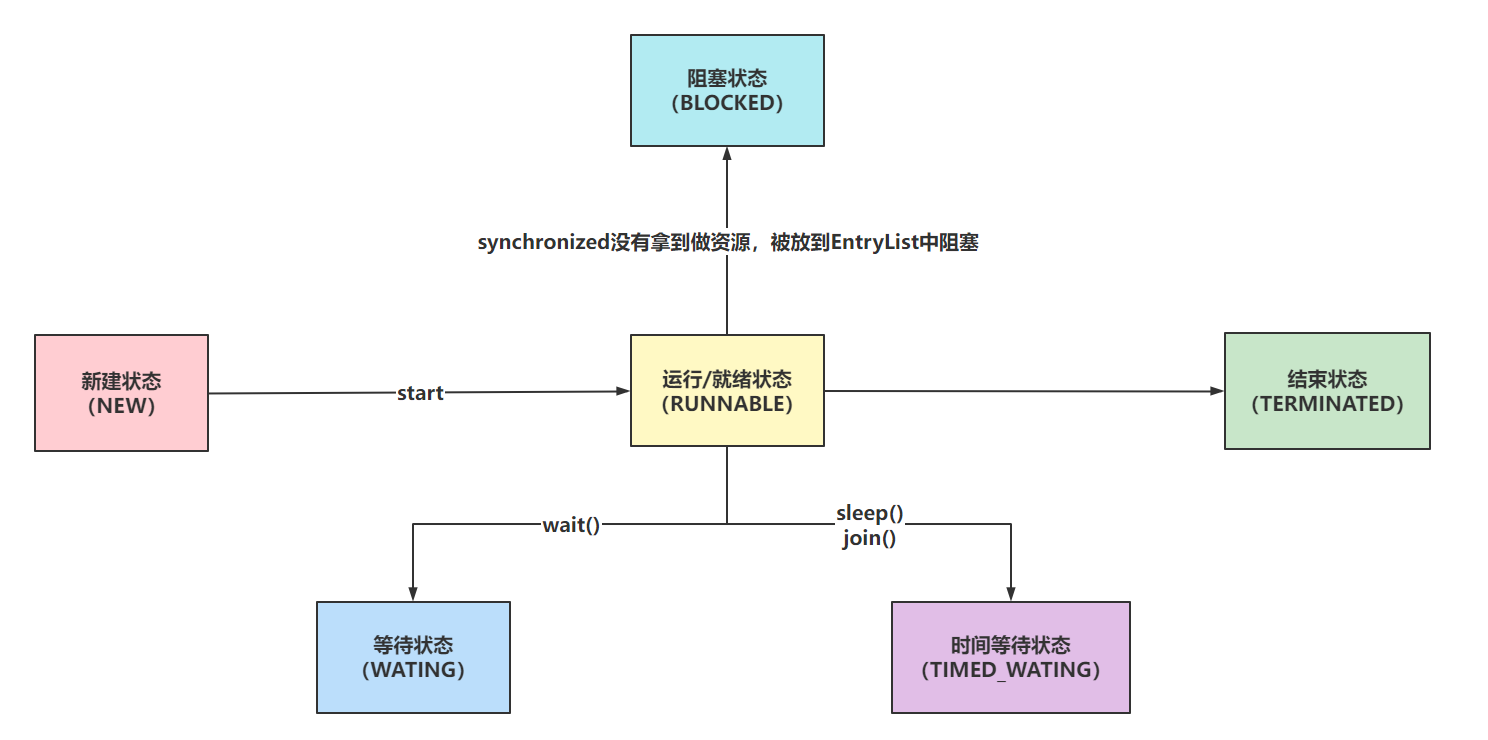二、线程的使用
分类:N07_Java
二、线程的使用
2.1 线程的状态
网上对线程状态的描述很多,有5种,6种,7种,都可以接受
5中状态一般是针对传统的线程状态来说(操作系统层面)

Java中给线程准备的6种状态

NEW:Thread对象被创建出来了,但是还没有执行start方法。
RUNNABLE:Thread对象调用了start方法,就为RUNNABLE状态(CPU调度/没有调度)
BLOCKED、WAITING、TIME_WAITING:都可以理解为是阻塞、等待状态,因为处在这三种状态下,CPU不会调度当前线程
BLOCKED:synchronized没有拿到同步锁,被阻塞的情况
WAITING:调用wait方法就会处于WAITING状态,需要被手动唤醒
TIME_WAITING:调用sleep方法或者join方法,会被自动唤醒,无需手动唤醒
TERMINATED:run方法执行完毕,线程生命周期到头了
在Java代码中验证一下效果
NEW:
public static void main(String[] args) throws InterruptedException {
Thread t1 = new Thread(() -> {
});
System.out.println(t1.getState());
}
RUNNABLE:
public static void main(String[] args) throws InterruptedException {
Thread t1 = new Thread(() -> {
while(true){
}
});
t1.start();
Thread.sleep(500);
System.out.println(t1.getState());
}
BLOCKED:
public static void main(String[] args) throws InterruptedException {
Object obj = new Object();
Thread t1 = new Thread(() -> {
// t1线程拿不到锁资源,导致变为BLOCKED状态
synchronized (obj){
}
});
// main线程拿到obj的锁资源
synchronized (obj) {
t1.start();
Thread.sleep(500);
System.out.println(t1.getState());
}
}
WAITING:
public static void main(String[] args) throws InterruptedException {
Object obj = new Object();
Thread t1 = new Thread(() -> {
synchronized (obj){
try {
obj.wait();
} catch (InterruptedException e) {
e.printStackTrace();
}
}
});
t1.start();
Thread.sleep(500);
System.out.println(t1.getState());
}
TIMED_WAITING:
public static void main(String[] args) throws InterruptedException {
Thread t1 = new Thread(() -> {
try {
Thread.sleep(1000);
} catch (InterruptedException e) {
e.printStackTrace();
}
});
t1.start();
Thread.sleep(500);
System.out.println(t1.getState());
}
TERMINATED:
public static void main(String[] args) throws InterruptedException {
Thread t1 = new Thread(() -> {
try {
Thread.sleep(500);
} catch (InterruptedException e) {
e.printStackTrace();
}
});
t1.start();
Thread.sleep(1000);
System.out.println(t1.getState());
}
2.2 线程的常用方法
2.2.1 获取当前线程
Thread的静态方法获取当前线程对象
public static void main(String[] args) throws ExecutionException, InterruptedException {
// 获取当前线程的方法
Thread main = Thread.currentThread();
System.out.println(main);
// "Thread[" + getName() + "," + getPriority() + "," + group.getName() + "]";
// Thread[main,5,main]
}
2.2.2 线程的名字
在构建Thread对象完毕后,一定要设置一个有意义的名称,方面后期排查错误
public static void main(String[] args) throws ExecutionException, InterruptedException {
Thread t1 = new Thread(() -> {
System.out.println(Thread.currentThread().getName());
});
t1.setName("模块-功能-计数器");
t1.start();
}
2.2.3 线程的优先级
其实就是CPU调度线程的优先级、
java中给线程设置的优先级别有10个级别,从1~10任取一个整数。
如果超出这个范围,会排除参数异常的错误
public static void main(String[] args) throws ExecutionException, InterruptedException {
Thread t1 = new Thread(() -> {
for (int i = 0; i < 1000; i++) {
System.out.println("t1:" + i);
}
});
Thread t2 = new Thread(() -> {
for (int i = 0; i < 1000; i++) {
System.out.println("t2:" + i);
}
});
t1.setPriority(1);
t2.setPriority(10);
t2.start();
t1.start();
}
2.2.4 线程的让步
可以通过Thread的静态方法yield,让当前线程从运行状态转变为就绪状态。
public static void main(String[] args) throws ExecutionException, InterruptedException {
Thread t1 = new Thread(() -> {
for (int i = 0; i < 100; i++) {
if(i == 50){
Thread.yield();
}
System.out.println("t1:" + i);
}
});
Thread t2 = new Thread(() -> {
for (int i = 0; i < 100; i++) {
System.out.println("t2:" + i);
}
});
t2.start();
t1.start();
}
2.2.5 线程的休眠
Thread的静态方法,让线程从运行状态转变为等待状态
sleep有两个方法重载:
第一个就是native修饰的,让线程转为等待状态的效果
第二个是可以传入毫秒和一个纳秒的方法(如果纳秒值大于等于0.5毫秒,就给休眠的毫秒值+1。如果传入的毫秒值是0,纳秒值不为0,就休眠1毫秒)
sleep会抛出一个InterruptedException
public static void main(String[] args) throws InterruptedException {
System.out.println(System.currentTimeMillis());
Thread.sleep(1000);
System.out.println(System.currentTimeMillis());
}
2.2.6 线程的强占
Thread的非静态方法join方法
需要在某一个线程下去调用这个方法
如果在main线程中调用了t1.join(),那么main线程会进入到等待状态,需要等待t1线程全部执行完毕,在恢复到就绪状态等待CPU调度。
如果在main线程中调用了t1.join(2000),那么main线程会进入到等待状态,需要等待t1执行2s后,在恢复到就绪状态等待CPU调度。如果在等待期间,t1已经结束了,那么main线程自动变为就绪状态等待CPU调度。
public static void main(String[] args) throws InterruptedException {
Thread t1 = new Thread(() -> {
for (int i = 0; i < 10; i++) {
System.out.println("t1:" + i);
try {
Thread.sleep(1000);
} catch (InterruptedException e) {
e.printStackTrace();
}
}
});
t1.start();
for (int i = 0; i < 10; i++) {
System.out.println("main:" + i);
try {
Thread.sleep(1000);
} catch (InterruptedException e) {
e.printStackTrace();
}
if (i == 1){
try {
t1.join(2000);
} catch (InterruptedException e) {
e.printStackTrace();
}
}
}
}
2.2.7 守护线程
默认情况下,线程都是非守护线程
JVM会在程序中没有非守护线程时,结束掉当前JVM
主线程默认是非守护线程,如果主线程执行结束,需要查看当前JVM内是否还有非守护线程,如果没有JVM直接停止
public static void main(String[] args) throws InterruptedException {
Thread t1 = new Thread(() -> {
for (int i = 0; i < 10; i++) {
System.out.println("t1:" + i);
try {
Thread.sleep(1000);
} catch (InterruptedException e) {
e.printStackTrace();
}
}
});
t1.setDaemon(true);
t1.start();
}
2.2.8 线程的等待和唤醒
可以让获取synchronized锁资源的线程通过wait方法进去到锁的等待池,并且会释放锁资源
可以让获取synchronized锁资源的线程,通过notify或者notifyAll方法,将等待池中的线程唤醒,添加到锁池中
notify随机的唤醒等待池中的一个线程到锁池
notifyAll将等待池中的全部线程都唤醒,并且添加到锁池
在调用wait方法和notify以及norifyAll方法时,必须在synchronized修饰的代码块或者方法内部才可以,因为要操作基于某个对象的锁的信息维护。
public static void main(String[] args) throws InterruptedException {
Thread t1 = new Thread(() -> {
sync();
},"t1");
Thread t2 = new Thread(() -> {
sync();
},"t2");
t1.start();
t2.start();
Thread.sleep(12000);
synchronized (MiTest.class) {
MiTest.class.notifyAll();
}
}
public static synchronized void sync() {
try {
for (int i = 0; i < 10; i++) {
if(i == 5) {
MiTest.class.wait();
}
Thread.sleep(1000);
System.out.println(Thread.currentThread().getName());
}
} catch (InterruptedException e) {
e.printStackTrace();
}
}
2.3 线程的结束方式
线程结束方式很多,最常用就是让线程的run方法结束,无论是return结束,还是抛出异常结束,都可以
2.3.1 stop方法(不用)
强制让线程结束,无论你在干嘛,不推荐使用当然当然方式,但是,他确实可以把线程干掉
public static void main(String[] args) throws InterruptedException {
Thread t1 = new Thread(() -> {
try {
Thread.sleep(5000);
} catch (InterruptedException e) {
e.printStackTrace();
}
});
t1.start();
Thread.sleep(500);
t1.stop();
System.out.println(t1.getState());
}
2.3.2 使用共享变量(很少会用)
这种方式用的也不多,有的线程可能会通过死循环来保证一直运行。
咱们可以通过修改共享变量在破坏死循环,让线程退出循环,结束run方法
static volatile boolean flag = true;
public static void main(String[] args) throws InterruptedException {
Thread t1 = new Thread(() -> {
while(flag){
// 处理任务
}
System.out.println("任务结束");
});
t1.start();
Thread.sleep(500);
flag = false;
}
2.3.3 interrupt方式
共享变量方式
public static void main(String[] args) throws InterruptedException {
// 线程默认情况下, interrupt标记位:false
System.out.println(Thread.currentThread().isInterrupted());
// 执行interrupt之后,再次查看打断信息
Thread.currentThread().interrupt();
// interrupt标记位:ture
System.out.println(Thread.currentThread().isInterrupted());
// 返回当前线程,并归位为false interrupt标记位:ture
System.out.println(Thread.interrupted());
// 已经归位了
System.out.println(Thread.interrupted());
// =====================================================
Thread t1 = new Thread(() -> {
while(!Thread.currentThread().isInterrupted()){
// 处理业务
}
System.out.println("t1结束");
});
t1.start();
Thread.sleep(500);
t1.interrupt();
}
通过打断WAITING或者TIMED_WAITING状态的线程,从而抛出异常自行处理
这种停止线程方式是最常用的一种,在框架和JUC中也是最常见的
public static void main(String[] args) throws InterruptedException {
Thread t1 = new Thread(() -> {
while(true){
// 获取任务
// 拿到任务,执行任务
// 没有任务了,让线程休眠
try {
Thread.sleep(1000);
} catch (InterruptedException e) {
e.printStackTrace();
System.out.println("基于打断形式结束当前线程");
return;
}
}
});
t1.start();
Thread.sleep(500);
t1.interrupt();
}
wait和sleep的区别?
单词不一样。
sleep属于Thread类中的static方法、wait属于Object类的方法
sleep属于TIMED_WAITING,自动被唤醒、wait属于WAITING,需要手动唤醒。
sleep方法在持有锁时,执行,不会释放锁资源、wait在执行后,会释放锁资源。
sleep可以在持有锁或者不持有锁时,执行。 wait方法必须在只有锁时才可以执行。
wait方法会将持有锁的线程从owner扔到WaitSet集合中,这个操作是在修改ObjectMonitor对象,如果没有持有synchronized锁的话,是无法操作ObjectMonitor对象的。